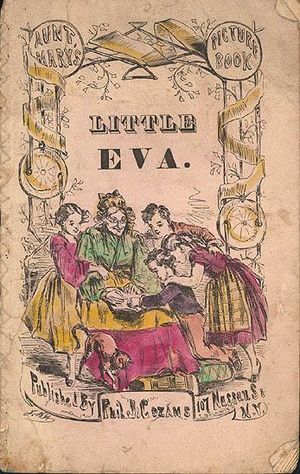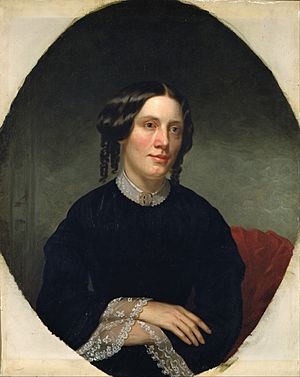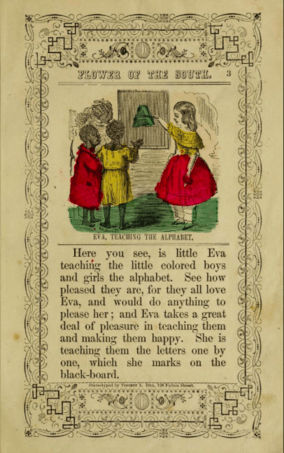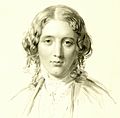Little Eva: The Flower of the South facts for kids

Front cover of the first edition, stereotyped by Vincent Dill
|
|
| Author | Philip J. Cozans |
|---|---|
| Illustrator | Vincent Dill (stereotyper) |
| Country | United States |
| Language | English |
| Genre | Anti-Tom literature |
| Published | Philip J. Cozans |
| Media type | Print (hardcover) |
| Pages | 8 (first edition) |
| OCLC | 990067664 |
Little Eva: The Flower of the South is a children's book written by Philip J. Cozans. It is known as an "Anti-Tom" book. This means it was written as a response to Uncle Tom's Cabin, a famous novel by Harriet Beecher Stowe that criticized slavery in the United States.
The book's exact release date is not known, but experts believe it came out in the 1850s or early 1860s. It tells the story of Little Eva, a kind girl who is the daughter of a rich Alabama plantation owner. She is shown as being very kind to the slaves on her family's land. Little Eva reads the Bible to them and teaches the alphabet to the slave children.
On her ninth birthday, Little Eva almost drowns. A slave named Sam saves her. Because of his brave act, Little Eva's parents free Sam. However, Sam chooses to stay with the family because he cares for them deeply. Little Eva: The Flower of the South was one of the few "Anti-Tom" books made specifically for children.
Contents
What is This Book About?
Little Eva lives in Alabama and is the daughter of a wealthy plantation owner. People call her the "Flower of the South" because she is so kind. She teaches the alphabet to the slave children, and everyone enjoys these lessons.
Little Eva also takes care of her old nursemaid. She brings her chicken broth and shares the latest news. The nursemaid loves Little Eva's company and tells her stories about when she was a baby.
Every Sabbath (Sunday) morning, Little Eva reads the Bible to the slaves. Even though she has taught some of them to read, they still prefer to listen to her. Little Eva often wakes up early to walk around and pick flowers for her mother. On her ninth birthday, she tries to pick grass near some water, falls in, and almost drowns. A slave named Sam quickly rescues her. Little Eva gives Sam a Bible as a thank you. Her parents then decide to free Sam. He chooses to stay with the family because he loves them.
Why Was This Book Written?
Little Eva: The Flower of the South is part of a group of books called Anti-Tom literature. These books were written to respond to Harriet Beecher Stowe's famous 1852 novel, Uncle Tom's Cabin. Stowe's book criticized slavery in the United States.
"Anti-Tom" books were similar to earlier "plantation novels." However, "Anti-Tom" books focused much more on slavery, often trying to show it in a positive light. Experts like Lisa Hinrichsen and Michael Pitts say that Little Eva: The Flower of the South helped to make the Southern way of life seem romantic. It also went against the ideas of people who wanted to end slavery, known as abolitionists.
Philip J. Cozans, the writer and publisher of this book, was already known for his children's books. He likely saw how popular Uncle Tom's Cabin was and decided to publish his own "Little Eva" books.
Little Eva's Character
Cozans used the character of Little Eva from Uncle Tom's Cabin but made her the main character in his books. In Stowe's original novel, Little Eva was a minor character. Historian Robert D. Morritt noted that the two versions of Little Eva are similar in some ways. Other children's books also made Little Eva a main character, such as All about Little Eva from 1853.
Cozans gave Little Eva the nickname "Flower of the South." He also changed some things about her story. In Cozans' book, the story takes place in Alabama, not New Orleans. Little Eva is saved by Sam, not Uncle Tom. Cozans also made Little Eva older, from six to nine years old. Both Stowe and Cozans showed Little Eva as a kind person. However, Cozans' version of Little Eva did not seem to have any problems with slavery itself.
Little Eva as a Teacher
A key idea in Little Eva: The Flower of the South is education during the slave period in the United States. The idea of Little Eva as a teacher first became popular from an illustration in the first edition of Uncle Tom's Cabin. This picture showed Little Eva teaching Tom, even though the book itself described him more as her friend than her student.
Children's book writers, like Cozans, and illustrators further developed this idea. In Uncle Tom's Cabin, Stowe only briefly connected Little Eva with education. She wrote that Little Eva told slaves to become Christians and go to Bible readings. But unlike Cozans' book, Little Eva in Uncle Tom's Cabin did not organize classes for slaves.
Cozans' book shows education as something where a kind teacher helps slaves learn to read. It suggests that white people needed to be involved in teaching slaves. Experts have noted that Little Eva is shown as an ideal "Southern belle" (a young woman from the American South). She uses teaching to fulfill the idea of Noblesse oblige, which means that people with wealth or power have a duty to help others.
Images for kids




